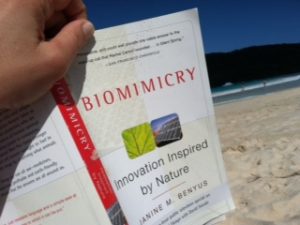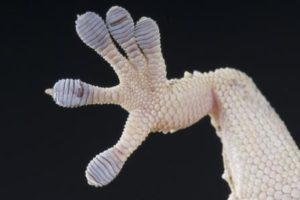 I am one of few non-scientists at Biohabitats. A little known truth around here is that I met my college science requirements by taking courses in psychology and computer science. So when it was time for me to research biomimicry for the latest issue of Leaf Litter, I was more than a little nervous.
I am one of few non-scientists at Biohabitats. A little known truth around here is that I met my college science requirements by taking courses in psychology and computer science. So when it was time for me to research biomimicry for the latest issue of Leaf Litter, I was more than a little nervous.
I bought Janine Benyus’ 1997 book Biomimicry: Innovation Inspired by Nature, and steeled myself for a long, difficult read. I read the first sentence (“It’s not ordinary for a bare-chested man wearing jaguar teeth and owl feathers to grace the pages of The New Yorker, but these are not ordinary times.“) and gasped. This book is in plain English! And I’m intrigued!
Benyus’ introduction goes on to describe a Huaorani Indian Leader from the Amazon who, during hearings in Washington, DC, actually roared like a jaguar to defend his homeland against oil drilling. The fact that this powerful act made mainstream headlines at a time when books about aboriginal peoples were becoming best sellers helped confirm Benyus’ belief that the industrialized world was “hungry for instructions about how to live sanely and sustainably on the Earth.” I had recently edited an issue of Leaf Litter on Traditional Ecosystem Knowledge, so this struck a chord.
But the instructions Benyus explores in her book are drawn from more than just indigenous peoples. In fact, she goes back 3.8 billion years to the first bacteria. Now, for someone whose entire knowledge of bacteria could fit into something the size of, say, a bacterial cell, this had me a bit worried. But I quickly realized that the concept of biomimicry is pretty darned simple. Nature has already invested 3.8 billion years in research and development, trial and error. In that time, life has not only survived, but learned to harness energy, fly, heal, make materials, etc. Why are we not turning to nature for guidance in…heck, nearly everything?
 As I read, I became fascinated with Benyus’ stories of real, live innovators who have turned to nature as model, mentor and measure in an effort to transform the way we grow food, generate energy, design and create materials, and even conduct business. (Seriously. I loved this book so much I read it on vacation!)
As I read, I became fascinated with Benyus’ stories of real, live innovators who have turned to nature as model, mentor and measure in an effort to transform the way we grow food, generate energy, design and create materials, and even conduct business. (Seriously. I loved this book so much I read it on vacation!)
The next step in preparing for this issue was to take an online introductory course offered by Biomimicry 3.8. From the moment I first logged in to begin my course, a virtual journey (in the ecosystem of your choice!) through biomimicry basics, I was sucked in.
 The beautiful images, elegant graphics, and interactive nature of the course captivated my attention and imagination. The concepts are clearly explained, and supported by lots of case studies and video testimonials from biomicry practitioners. Before I took this course, had someone told me that I would stare, mouth agape, at a video of a gecko walking on a rotating, polished glass surface for several minutes, I would have laughed. Well, I’m not laughing. I was — and am — amazed. We have so much to gain by adhering to the wisdom life has amassed over 3.8 billion years.
The beautiful images, elegant graphics, and interactive nature of the course captivated my attention and imagination. The concepts are clearly explained, and supported by lots of case studies and video testimonials from biomicry practitioners. Before I took this course, had someone told me that I would stare, mouth agape, at a video of a gecko walking on a rotating, polished glass surface for several minutes, I would have laughed. Well, I’m not laughing. I was — and am — amazed. We have so much to gain by adhering to the wisdom life has amassed over 3.8 billion years.
Further Reading
Meet Assistant Construction Project Team Leader Bryan SullivanMeet Conservation Biologist Nolan Schillerstrom
Get to know Allyson Gibson, Biohabitats Extern
Get to Know Graphic Designer Joey Marshall
Evolution: A New Leadership Team for Biohabitats
More From This Author
COP10: Could biodiversity offsets be the answer?Get to know Antanea “Nea” Davis, Office Manager
Thoughts on Salamanders
Get to know Environmental Technician, Austin Vong
Thoughts On Coral Reef Restoration

